T-Mobile Park
| Setting | 15.5/20 | 1 Thumb Up |
|---|---|---|
| Locale | 3.5/5 | Thumb Sideways |
| Accessibility | 3.5/5 | Thumb Sideways |
| Neighborhood Local Scene | 8.5/10 | 1 Thumb Up |
| Architecture & Aesthetics | 38/65 | 1 Thumb Down |
|---|---|---|
| Exterior Design/Aesthetics | 9/20 | 1 Thumb Down |
| Interior Aesthetics/Visuals | 25/40 | Thumb Sideways |
| Concourse Aesthetics | 4/5 | 1 Thumb Up |
| Functionality & Essentials | 41.5/50 | 1 Thumb Up |
|---|---|---|
| Sightlines: Field Proximity | 10.5/15 | Thumb Sideways |
| Sightlines: Seating Geometry | 4/5 | 1 Thumb Up |
| Seat Comfort | 6.5/9 | Thumb Sideways |
| Concourse Functionality | 14.5/15 | 2 Thumbs Up |
| Scoreboards/Tech | 6/6 | 2 Thumbs Up |
| Amenities & Features | 42.5/50 | 2 Thumbs Up |
|---|---|---|
| Concessions: Food Variety | 5/5 | 2 Thumbs Up |
| Concessions: Food Quality | 5/5 | 2 Thumbs Up |
| Concessions: Craft Beer/Other Drinks | 5/5 | 2 Thumbs Up Star |
| Social Gathering Areas/Restaurants | 8/10 | 1 Thumb Up |
| Premium Seating/Clubs | 7/9 | 1 Thumb Up |
| Historical Exhibits, Memorabilia, Art, & Other Displays | 8.5/10 | 1 Thumb Up |
| Kids Areas/Other Entertainment | 4/6 | 1 Thumb Up |
| Atmosphere, Vibe, & Policies | 12/15 | 1 Thumb Up |
|---|---|---|
| Fan Support/Attendance | 4/5 | 1 Thumb Up |
| Ballpark Traditions/Gameday Presentation | 3.5/5 | Thumb Sideways |
| Ballpark Policies/Staff | 4.5/5 | 1 Thumb Up |
| Adjusted Raw Score | 149.5/200= 74.75=75 |
|---|---|
| Bonus | 4 |
| Curve for All 7 | 7 |
| Final Score | 86 |
|---|---|
| Ranking | #13(t)/30 |
|---|---|
Caveats aside, Money Buys a First Class Jewel in the Emerald City
Despite overrated aesthetics, conflicting architecture, poor urban design, Safeco Field masterfully compensates by being the most ornate, fan-friendly venue in baseball
By Cole Shoemaker
Written in 2012, ratings above are up to date for 2023, but this review below is outdated and will be updated at some point during the 2023 season; reviews and ratings are “living pages” updated yearly when necessary
Note: This review refers to T-Mobile Park by its previous name, Safeco Field.
Safeco Field: for some reason, everybody’s favorite ballpark. The media darling of Seattle. A modern marvel. According to team officials, architects, and Mariner broadcasters, the best ballpark ever built.
It has always felt like a disproportionate amount of people on the net love Safeco Field. From Baseball Fever to Ballpark Chasers, fans, players, or any website, so many ballpark enthusiasts seem to have a connection to Seattle. The local media coverage when the ballpark opened was as extensive as I’ve ever seen, and that’s something I research every time before a review. There seems to be a pathological obsession to elevate this park, and for good reason if you’re just looking at the amenities. But other than Seattle based architectural critic John Pastier and a few other contrarians, I’m puzzled at the total lack acknowledgement that Safeco Field is by and large an aesthetic failure.
Yes, we get it Seattle. Safeco Field is a true open-air ballpark with a unique retractable roof that doesn’t enclose the field. It acts like an umbrella that keeps the rain out! (Admittedly, this is an unbelievably cool concept).
But this engineering marvel doesn’t compensate for the haphazardly constructed outfield grandstand scene, a total lack of interior aesthetic vision, and conflicting architecture.
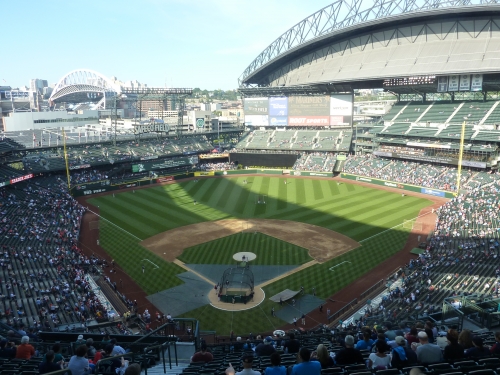
As anyone who didn’t drink the coolaid knows, Safeco Field’s $70 million retractable roof (more than two-thirds the cost of Camden Yards entirely!) was completely superfluous, as Seattle’s summer months are actually dryer than those in Chicago, Cleveland, or New York. It’s a nice convenience, but I don’t see how that point is arguable. The roof is an eyesore that fights the retro nature of the structure, completely dominating the ballpark in both scale and substance.
It’s a bad sign when a roof is your “signature feature”. If officials hadn’t given total priority to the retractable roof above all else, Safeco Field could have been better, especially in terms of the painfully confused exterior design.
In a ballpark located on the outskirts of downtown, Safeco Field largely fails in contextual integration, building an over scaled self-contained structure that doesn’t acknowledge its surroundings as well as it could, unlike its cousin in Houston. Seattle defies all attempts to provide some sort of signature interior element, whether being contextually based or having a superficial gimmick, other than its bulky metal retractable roof.
There’s nothing aesthetically attractive or locally distinguishing about Safeco Field if you’re sitting in the lower bowl. Seattle has the waterfront, the mountains, and the skyline, but Safeco Field doesn’t do enough to acknowledge these elements, because they just had to have that retractable roof. You wouldn’t know much of Seattle’s beauty of you were sitting in the lower bowl.
In reality, the interior is just a giant hunk of functional jet-black metal and steel, not that much different than Chase Field or Miller Park. Its only aesthetic success is maintaining an outdoor feel, unlike the aforementioned two. Minute Maid Park’s interior architecture and urban design is far superior, annoying gimmicks aside. I’ll explain later.

What’s funny is that in terms of amenities, Safeco might be the best in baseball. I guess its just overshadowed by the undeserved architectural acclamations. Safeco Field provides fans with so many little innovative conveniences unmatched even 12 years later. The concourses are extremely wide; it has more incredible standing room areas than any park built to date; Safeco has more artistic projects than any other venue; the food is truly spectacular; the Hall of Fame is awesome; etc; etc. At over $500 million, it’s an extremely ornate facility, with no lavish expense withheld. And now in 2013, with the addition of the new videoboard, it may be the most objectively superior experience in the majors.
When you take it all together, Safeco Field is probably the most fan friendly facility in sports, especially with the addition of “The Pen” in 2011 and Edgar’s Cantina in 2013. In no other ballpark, can any fan walk right up to the centerfield wall or have an unobstructed view of the bullpens only inches away. Safeco does so many little things right. It’s the one ballpark in the majors where I feel like I took more pictures of the concourses than of the field.

So Safeco Field is still a great ballpark, but because it seems so overhyped to me, I feel like the fact that its not that aesthetically outstanding overshadows its unbelievable features and fan friendly atmosphere.
It’s largely about expectations, as I expected to go on this diatribe about how Safeco is overrated, and it certainly is in terms of architecture, but it’s obviously an amazing facility. Unfortunately, aesthetics are everything, so it’s not going to rate as highly as it could overall. But I now understand anyone that says this is a top 5 ballpark. It’s hard to believe it opened in 1999, because in many ways no ballpark has come close to the effort in Seattle since. It just falls so terribly short in aesthetic design.
Setting
Location/Access:
While any architectural criticism is certainly up for debate, one objective flaw, again overlooked by many critics for some reason, is Safeco Field’s location well south of downtown. The Mariners wanted their new ballpark south of the Kingdome to gain more parking and concession money, instead of more integrated with the city center to the north, a potential fixture in Pioneer Square. There’s no doubt Safeco is in the wrong place.
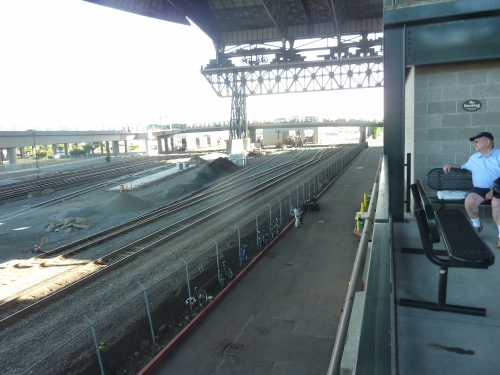
Out of the three hypothetical locations of Seattle’s new ballpark, the Mariners picked the outer most location, separated from the city center. Safeco Field is located in the lower part of SoDo, a district south of downtown, bounded by Dave Niehaus Way South and Edgar Martinez Drive South. One unique factor is the railroad tracks to the east, located in the back of right field. The area itself is characterized by a number of warehouses and industrial sites. The ballpark is relatively accessible, as the interstate and I-5 go right by the area. Nearby parking is generally limited and expensive, but there are plenty of cheaper areas in the vicinity. The light rail is commonly used as well.
Score: 3.5/5
Local Scene:
The immediate local scene is one of the weakest for downtown major league ballparks, but Pioneer Square close by really helps the score. The scene directly outside the ballpark is oddly barren, especially noting the Great Floors store right outside the home plate entrance. The Pyramid Alehouse across the street from the left-field entrance is the only place of note.

Pioneer Square well north of the ballpark is filled with numerous coffee shops, bars, and breweries. The nightlife is sometimes said to be the best in Seattle. Be sure to check out Merchants Café, Seattle’s oldest restaurant. The historical merits of the area definitely would have facilitated the classic “ballpark neighborhood” had the Mariners decided to build Safeco north of the Kingdome, integrated with the community. It could have been “Wrigleyville west”, a neighborhood equal to that of the Petco or Coors.
Score: 3.5/5
Total: 7/10
Architecture & Aesthetics
Exterior Design:
Even Safeco Field apologists generally agree that the exterior design is an architectural misfit, in what is perhaps the most disjointed stadium ever seen. Half the ballpark emphasizes the rationalist steelwork, while the other half is wrapped in a retro facade. You can’t do both.
Considering the modern nature of the jet-black retractable roof, the Mariners should have chosen to accentuate the steel trusses of the super structure, building a decidedly modern industrial ballpark. But no, they just had to have a “retro park.” If you’re going to have a modern retractable roof that dominates the stadium, then why construct architecture that meekly tries to fight it? It all comes out as a painfully confused structure, as the steel trusses and roof are disproportionately scaled in comparison to the retro architecture.
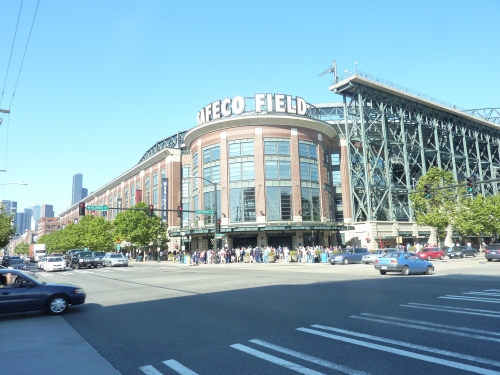
When looked at alone, the metal walls and exposed steelwork that dominate the outside are surprisingly quite impressive, evoking a classic structural rationalism seen in no ballpark in the majors. But the brick wrapped third base façade is not only painfully out of place and cliché, but it is not comparable to other retro exteriors across the majors. Lacking many of the unique embellishments and flares usually seen, the design is characterized by a streamlined verticality that comes off as decidedly uninspiring. The vague attempt to form an arch-like look on the third base facade with the combination of glasswork is particularly primitive. Even if they had wrapped the entire structure in this red brick design, it would have been only slightly less disastrous.
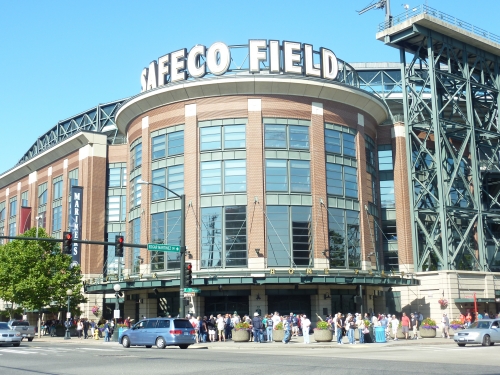
Ultimately, the amalgam of conflicting elements makes Safeco Field one of the odder-looking ballparks in the majors. People have often said that the Mariners had a mandate to build a retro ballpark, and the state of the art retractable roof nullifies the classic feel.
But the truth is, the Mariners inevitably built a modern industrial steel ballpark because of its functionality, but made a weak attempt to force brick into the ballpark schema, fighting the true metallic-based aesthetic.
Score: 4.5/10
Interior Aesthetics:
While Safeco Field scores high in most objective criteria, the interior design is mostly characterized by total disregard for aesthetic purpose, stressing functionality above all else. The ballpark’s outfield scene lacks any defining focal point, with poor attention to the urban context and with haphazardly placed outfield grandstands.
Safeco Field is another retractable roof ballpark where it appears the functionality of the structure took precedence over its set up as a ballpark. Like Miller Park in Milwaukee, it looks like the architects took an “outside-in” or additive construction approach, where the superstructure is built first and the grandstands appear to be aimlessly added as an afterthought. It doesn’t matter what the intention was. Take careful note of the placement of the bleachers in left and center field. The outside steelwork was constructed first then the bleachers were added to fill empty space. The outfield scene looks forced and not organically constructed.

Note how poorly space is used in the outfield. There are large, awkward holes in the outfield-seating pattern that are completely non-existent in more design conscious ballparks. Specifically note the open triangular area in between the left and center field bleachers and the wide-open space to the right of the scoreboard. Tightening the layout would have approved the appearance immensely. There’s little continuity anywhere in this unintentionally deconstructivist mess of an outfield scene.
There is simply no attention to balance or consistency here, as a disproportionate amount of time and money was spent on the retractable roof instead of beautifying the aesthetic scene. Contextually, Safeco Field is often known for the train tracks behind right field, but it makes no attempt to integrate the concept literally or figuratively. For having a decent location, it’s a surprisingly insular ballpark.
Safeco has the misfortune of having no distinguishing features on the inside other than the ugly retractable roof hovering over the field. While it should be lauded for not overloading the senses, Safeco Field generally airs on the side of too simple in terms of unique architectural design flares on the inside. There’s little to say because there’s no aesthetic vision here whatsoever.
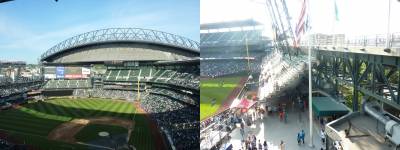
For what its worth, the design does deserve credit from refraining from any cheesy gimmicks or contrived quirks. Safeco Field’s outfield dimensions are refreshingly simple, mimicking the Spartan set up of the grandstands.
The outfield scene may be plain, but at least they don’t try to contradict the simple interior lines with loud annoyances like Turner Field or Great American Ballpark. Safeco Field is confident in its utilitarian architectural lines.
But that doesn’t excuse its total lack in aesthetic appeal, as an excess of cavernous seating consumes too much of the area. While it went a bit over the top, the similarly designed roofed ballpark in Houston is a perfect example of how Safeco Field could have been, in terms of contextual integration and aesthetic integrity. And no, I’m not advocating putting a silly hill in center field or building a choo-choo train!
Minute Maid Park took one contextual element in the local community, Union Station (the old train station), and used it as a framework for the ENTIRE ballpark, including the roof. Safeco Field ignored Pioneer Square and the train reference and built a self-contained structure that blocks out the context. Where Safeco Field has parking garages and a football stadium, Minute Maid has Union Station and the Courthouse. Where Safeco Field thoughtlessly plopped unadorned bleachers, Minute Maid has a promenade of beige stone arches, matching, not fighting, the exterior retro treatment. Where Safeco Field has a bland black batter’s eye, Minute Maid has plush greenery. Where Safeco Field lacks any sense of spatial reasoning with its cavernous array of seats, Minute Maid has continuity and a more intimate scale. Where Safeco has a sharp disparity between retro and modern treatment, Minute Maid is both consistent and coherent in its 19th century train-station inspired lacy iron architecture, even regarding the retractable roof. To add insult to injury, Minute Maid’s open roof reveals more open air space.
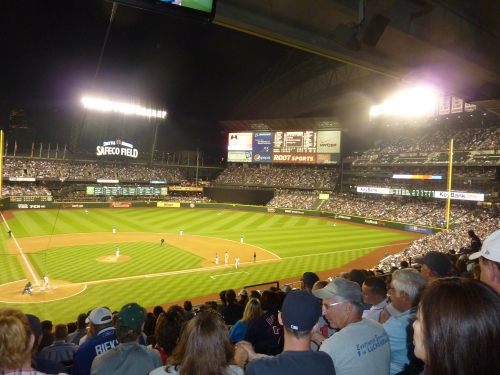
The only reason Safeco Field is generally considered better is because it lacks the highly criticized kitschy gimmicks of Minute Maid Park, and it better exhibits an open atmosphere than any other retractable roof ballpark. Both are certainly valid points, but I don’t get why they carry so much weight. By the way, these are probably the most original insights I’ve ever written on the web. I don’t know why I’m the first to favor Minute Maid Park over Safeco, aesthetically speaking.
Safeco Field has done some things right. The color of the seats is a slightly darker shade of green, reflecting the northwest wintergreen character. The analog clock integrated into the Mariners’ compass rose logo above the left field bleachers is a wonderful artistic touch. The extended canopy in the upper deck is both functional and attractive. The fact that the exposed wrought iron work at the top of the upper deck looks like any other open-air ballpark, unlike Minute Maid, Miller, and Chase, is particularly revealing. I will concede that I consider Safeco Field an open-air ballpark, which just happens to have a roof that covers it.
The way the left field upper deck is cut off, known, as “lookout landing,” is also very effective. It’s perfectly positioned to reveal the Space Needle. The aesthetic impact of the line created by the canopy is nicely juxtaposed with the extensions of the suite level, club level, and the lower upper deck, despite the fact the latter extensions certainly diminishes the impact in itself.

By default, in no way is the Safeco Field interior a total disaster. I don’t mean to imply that it’s worse than Miller Park or Chase Field, which are inherently enclosed ballparks. It’s confident in its architectural lines, while maintaining an open feel by default and capturing a gorgeous view from the upper deck, at least elevating it above the muddled messes in Queens and Atlanta.
But overall, it’s not as good as people would have you think, and any ballpark with a roof has aesthetic limitations. Just having a roof that doesn’t completely enclose the park doesn’t mean it’s the best looking place on earth.
But here’s some good news for Seattle fans: we’re about to get to some of the objective categories, where it might be the best ballpark on earth!
Score: 8.5/15
Panoramic View/Backdrop:
While distant, Safeco Field offers some of the best views in baseball, but only from certain areas in the upper deck. Again, if Seattle had built if farther north, the views would have truly been a fixture at Safeco Field. All seats on the right field side have a distant but picturesque view of the Seattle skyline in the background, with a parking garage in the foreground. Fans sitting farther to the right get a glimpse of the famous Space Needle. Even further to the right in the outfield upper deck, Puget Sound views become visible. While in the periphery, at least Safeco managed to capture all of its landmarks in some fashion.

Score: 4/5
Concourses:
Aesthetically, the concourse is designed in your typical arrangement of exposed green steel and concrete floors, accentuated by some of the grey stonework seen on the outside. However, Safeco Field’s concourses are highlighted by the profusion of art projects at every corner (which I’ll get to later) and the post card views. From the upper deck, there’s no question that Safeco Field has the best concourse views in baseball. Sweeping views of Puget Sound and downtown Seattle are the focal point.

Score: 3/3
Total: 20/33
Functionality & Essentials
Sightlines:
Safeco Field’s sightlines are consistently above average in a crowded landscape of new ballparks, characterized by decent enough seating geometry and comparatively good cantilevering of the upper deck.
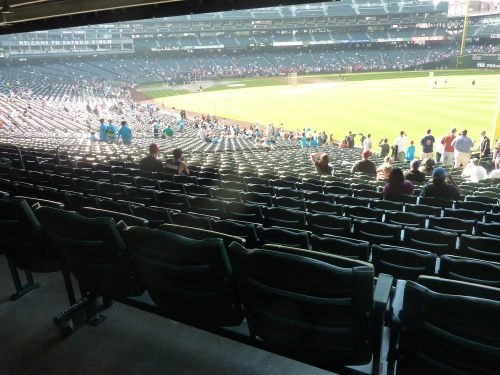
Seating angles in the lower bowl down the left and right field lines are generally good, with few stiff necks. The upper decks are only slightly more problematic, but they are generally solid. There’s not a bad seat in the house. It looks like NBBJ did a relatively good job in orienting seats, while HOK sometimes doesn’t. Some have pointed out the slightly poor angling of the center field bleachers, but I don’t see how this is a big deal because the seats are not fixed.
The cantilevers of the upper decks are very similar to other ballparks, using the club/suite decking formula. While there is little difference in the overhang of the mezzanine, the upper deck is admirably cantilevered. Other than Houston and San Diego it looks like Safeco has the farthest overhang with the upper deck, but not necessarily the closest, which also throws height into the equation. But generally speaking, Safeco Field benefits from better than average field proximity for its era.
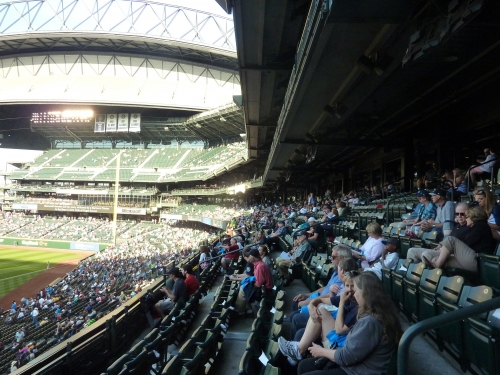
Score: 8.5/10
Seat Comfort:
Seat comfort at Safeco Field is what you would expect across the majors, characterized by roomy seats in premium areas and tight spaces in the upper decks. All seats have cup holders. Club seats and charter seats in the lower bowl are padded. The Mariners do prioritize seat comfort above other parks in some ways though: the bleachers have padded backs.
Score: 3.5/5
Concourses:
By far, Safeco Field’s biggest asset is it’s brilliantly designed concourse system, sporting wide-open viewing areas from all over the ballpark, while also succeeding from an aesthetic point of view. Seattle has more innovative standing room options than any other ballpark as well.
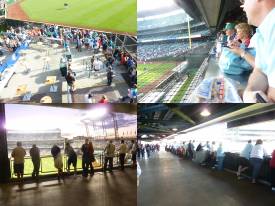
Unlike most others, Safeco Field’s main concourse is above street level, elevated one floor up, with the field at street level. While this is usually seen as an annoyance, like at AT&T Park and U.S. Cellular Field, Safeco Field turns it into an advantage. Fans are met at the grand rotunda with a duel set of escalators taking them up to the main level. This establishes an “embrace and release” sensation similar to Coors Field and the old ballparks.
The placement of the field at street level facilitates one of the most unique areas in sports by the bullpens. In left field, a wide-open area known as “The Pen” provides open views of both bullpens. Only in Seattle, can fans be within inches of relievers warming up. Similarly, there is a large patio area in center field where fans can walk right up to the fence.

The main concourse has a surplus of space, as wide as any seen today. The upper deck space has an unusual amount of room in some areas as well, despite being closed from the field. The 360-degree system has great visibility from all areas. Each set of bleachers has its own unique enclave as well. Standing room only space is given priority on all areas on the main concourse. Note the strategic placement of the staircase to the right of the center field scoreboard, where fans are invited to get a unique perch. There’s even an area above the center field bleachers for standing room fans. I can’t stress enough how wonderfully everything on the inside works from a functional point of view.
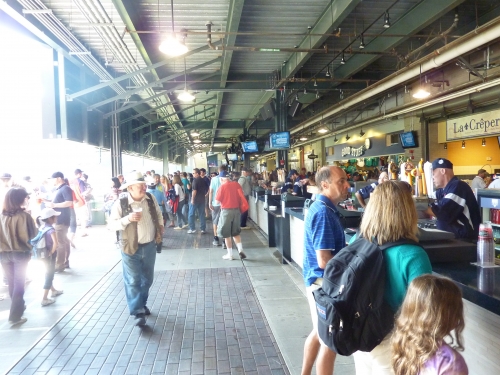
Score: 7/7
Scoreboard System:
Formerly, the only objective flaw at Safeco Field is the outdated video board system. While there is nothing they can do to change my take on the ballpark’s architecture, they added 2 points in their rating with the addition of the largest videoboard in all of baseball in 2013.

Score: 3/3
Total: 22/25
Amenities & Features
Quality and Selection of Concessions:
Safeco Field was generally regarded as having some of the best food in baseball for some time, but the 2011 addition of multiple gourmet chefs in “The Pen” elevates it to the transcendental status of AT&T Park. Roberto Santibanez’s Mexican beef Torta is the best food item I’ve ever had in a ballpark, to the point where I’d return back to Seattle just to have it again.
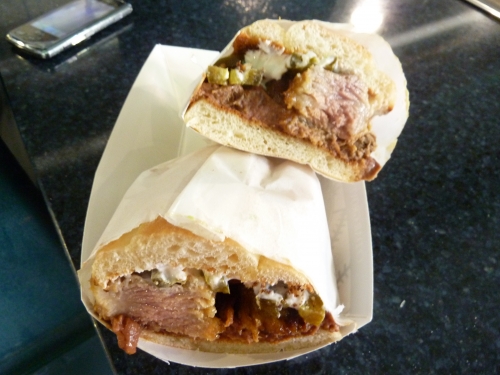
Safeco Field is now boldly claiming to be the culinary capital of sports. In “The Pen,” local chef Ethan Stowell serves grass-fed restaurant quality burgers, as well as delicious frites. La Creperie features authentic Parisian crepes. That’s right, crepes! Both sweet desert pastries and savory cheese specialties are available. Well-known chef Bill Pustari serves New Haven-style pizzas at Apizza, cooked in a gas oven in view of fans (and relievers).
Ballpark pizza usually sucks no matter where you go, so high quality cooked pizza is something I’ve long advocated. Restaurant quality Caesar salads are available. As previously mentioned, a number scrumptious Tortas are served as well, accompanied with fresh salsa and guacamole. The price is worth it: before you buy food anywhere else in the ballpark, try everything at The Pen!
Even without The Pen, the Mariners have some of the best food in all of baseball. Safeco Field is particularly known for having the widest variety of Asian cuisine in baseball, serving Thai food, Chinese, and Sushi. Rice N Roll provides an abundance of sushi specialties, including the famous Ichiroll, nigiri, Seattle roll, California roll, bento combo, and edamme. Teriyaki chicken highlights the Chinese food. They also have tofu noodle salads, miso soup, seaweed snakes and sake! Intentional Wok’s Thai Ginger serves authentic Thai food, including chicken curry, garlic beef, cashew chicken, and of course, Pad Thai.
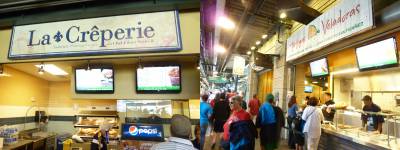
The Mariners do a good job in providing all of the other secondary options as well, some of which you wouldn’t expect in Seattle. Other than the Mexican food in “The Pen,” Tortilla Junction serves taco salads, specialty nachos, and burritos with the works. While not even attempting to match parks in the South, Holy Smoke BBQ has a reasonably nice selection of ballpark BBQ, including sliced brisket, pulled pork, hot links, and BBQ nachos. A rarity in baseball, Safeco Field has a stand exclusive to the upper deck, serving Gyros.
A number of local establishments have become a fixture at Safeco Field. Famous local fast food joint “Ivar’s”, the seafood of “In and Out” if you will, serves up local seafood. Fish and ships, clams, salmon sandwiches, salmon salads, clam chowder, and the famous Ivar Dog are all on the menu. Kidd Valley Hamburgers has the expected fare, including milkshakes. Grounder’s World Famous chicken wings and garlic fries were born at the ballpark.
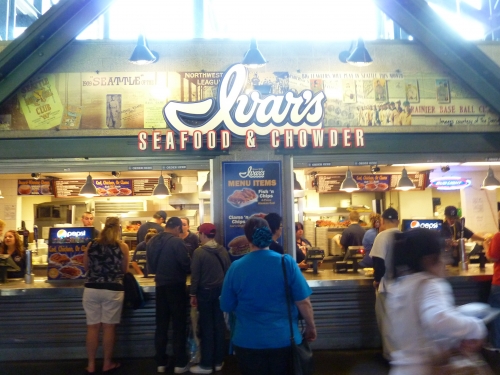
Safeco Field also has a number of offbeat or healthy food items that are certain to catch your attention. While technically outside the ballpark, Blazin’ Bagels is a unique option seen nowhere else in baseball. “The Natural” is the ballpark’s healthy stand, serving veggie burgers/dogs, turkey clubs, soups, hummus, fruit, and snack bars. Their organic smoothies are delicious. Needless to say, lots of coffee and wine stands fill the concourses. The “Sweetspot” in center field may have the most impressive candy selection ever seen in a ballpark.
Score: 5/5
Regional/Signature Concession(s):
Safeco Field is another rare ballpark where everything could be considered a signature food item, especially if it’s Asian or seafood. Pick any of the high quality concessions in “The Pen” or any of the local eateries.
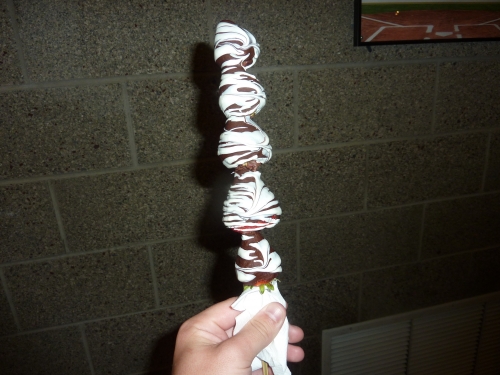
Ivar’s Grilled Salmon Sandwich is one unique regional item that has received a lot of press. The succulent fresh wild-caught fish is seasoned and served with fries on crusty organic bread, with tartar sauce. I really regret not getting this, but they didn’t have it at the upper deck location I was nearest to, so I forgot about it.
How could you mention Safeco Field’s signature food without delving into the famous Ichiroll, named after the famous Mariner? In terms of substance, it’s essentially a spicy tuna roll with black sesame seeds.
But perhaps Seattle’s most famous food is the unusual Shishkaberry’s, made up of fresh fruit on a stick dipped in chocolate with nuts. Countless varieties are available.
Score: 2/2
Public Restaurants/Bars/Sitting Areas:
Safeco Field has one full service restaurant, complemented by a number of innovative sitting areas located on multiple levels.
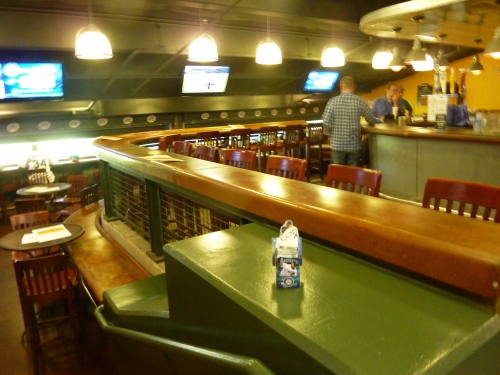
The Pen’s Caught Looking Lounge, serving cocktails, is a small area with Cambria stone surfaces and wood finishes. While mostly for show, it has a fireplace and multiple blue couches. Formerly known as the Bullpen Pub, the Flying Turtle Cantina is an incredibly original restaurant concept sandwiched underneath the manual scoreboard in left field, adding another unique viewing perch to Safeco Field’s repertoire.
The ballpark also has multiple sitting areas in the upper deck. Lookout Landing in left field provides a great view of the city. Seattle also has a rather large picnic area on top of the rotunda.
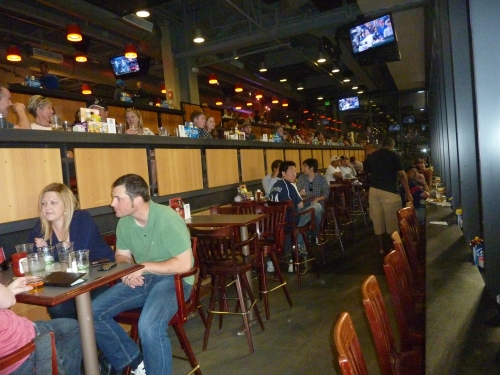
The Hit it Here Café is Safeco Field’s extensive public restaurant, featuring both indoor and outdoor seating. Located in left field, the dark oak décor is similar to the upscale restaurants across the league, but it is open to all fans. The tiered dining and bar area has great views of the field.
Due to an excess in capacity, they added a space formerly occupied by the left field seats called Edgar’s Cantina in 2013, which complements the already loaded left field area. This further solidifies Safeco Field as perhaps the most fan friendly ballpark in baseball and one of the most objectively superior experiences in baseball.
Score: 4.5/5
Premium Seating/Clubs:
While Safeco Field’s array of club seating may seem pretty standard today, Seattle was generally seen as one of the more revenue milking venues when it opened, with its charter seats and new seating options. Safeco Field was the first new ballpark to introduce the ultra premium Diamond Club seating concept to the industry.
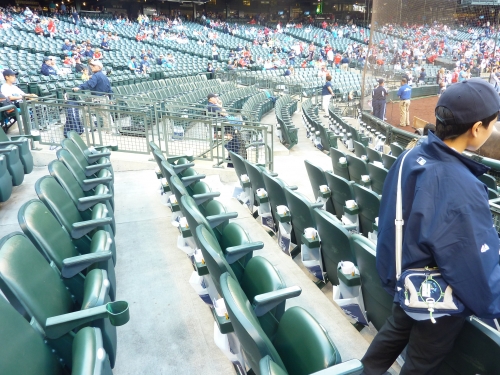
The KeyBank Diamond Club is simply exquisite, unexpectedly expansive and more luxurious than anything baseball had ever seen when Safeco opened. It features two lounge areas, highlighted by a circular bar. The main dining area a rather ordinary set of upscale wooden tables and chairs. The bistro area is as luxurious as any in the majors, characterized by black granite tabletops and cream leather sofas. The blue lighting of the oak laden circular bar is nice as well.
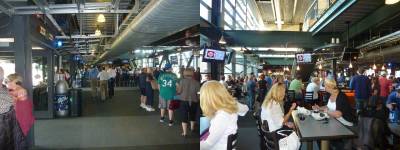
Safeco Field’s terrace club level is much less impressive, lacking the expansive luxurious concourses and upscale vibe of other club levels across the league. However, one unique innovation is the opening glass on the field side of the enclosed concourse, creating some nice airy viewing areas from the wooden end tables. One of the first things fans will notice is the exposed pipes and lack of ceiling enclosure, not different from the main concourse. The concourse areas are narrow and lacking the fit and finish that premium fans have come to expect. The outer lounges aren’t as nice either, consisting of plastic tables and chairs, along with an occasional lounge chair. For $517 million, why is the club level so comparatively lacking?
Score: 3.5/5
General or Artistic References to Baseball or Team History/Museums:
With the recent addition of the Mariners Hall of Fame along the main concourse, Safeco Field is automatically one of the better ballparks in honoring team history. But when you also consider the historic murals along the concourse and the famed “art in the park,” Safeco Field is a contender for the top spot in this category.
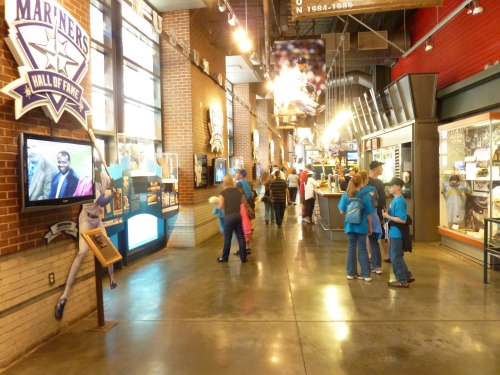
Integrated with the Pacific Northwest Baseball Museum, the Hall of Fame features bronze plaques of the four inducted members, Jay Buhner, Edgar Martinez, Dave Niehaus, and Alvin Davis. Each dedication briefly describes their achievements and includes TV highlights of their careers. Nicely situated with a bar, the area also includes player memorabilia and a picture cut out of each player.
The Pacific Northwest exhibition is particularly interesting, featuring practical displays involving the composition of bats and different types of gloves. The coolest concept is the replica outfield wall, where kids can pretend to be outfielders robbing home runs. In addition, above many of the concession stands are timelines of the history of baseball in Seattle, outlining the years of the Pacific Coast League, the Seattle Pilots, and recent Mariner history.
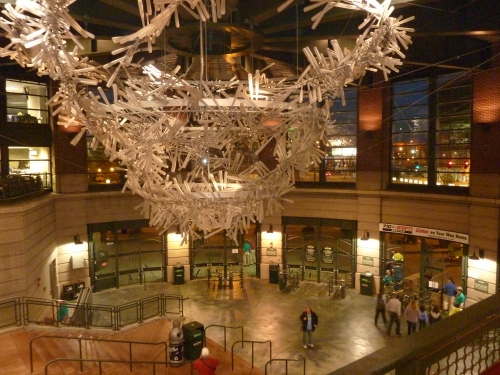
As far as I know, Safeco Field still has the most extensive public display of artistic projects of North American Stadia. Most impressive is the bedlam of 1000 translucent bat replicas forming a massive swirling chandelier, serving as the focal point inside the famous rotunda behind home plate. On the main concourse behind home plate, be sure to note the terrazzo compass rose as well. Other unique artworks include the quilts of each MLB team logo and the stainless steel cutouts of players integrated into the four main gates. The Children’s Hospital Wishing Well fountain in center field, depicting a bronze statue of a little leaguer, was the ballpark’s only statue for a while, until the Niehaus statue was erected in 2011 (Griffey next?). The Mitt outside the left field gate might be the most recognizable art of the ballpark exterior.
Score: 5/5
Entertainment/Kids Activities/Other Amenities:
While Safeco refrains from going over the top like Miller, Kauffman, and Turner, it has plenty of activities to distract the disinterested fan or bored child. Located in center field is the Children’s Hospital Playfield, a jungle gym for children. While not too expansive, it’s certainly a step up from what earlier parks provide, like Denver or Cleveland. Nearby, behind the center field batter’s eye is a speed pitch game. Be sure to check out Mariner Moose’s Den as well.

Score: 2/3
Total: 22/25
Atmosphere, Vibe, & Policies
Atmosphere/Fan Support:
Again similar to the Astros in Houston, yearly attendance numbers indicate Mariner fans have sustained loyalty longer than one would usually expect when compared to team record. People generally underestimate the residual impact of past success on future attendance. Seattle continued to draw well over 30,000 fans for 6 straight years after the record setting 116 win season. Perhaps more striking, during half of that period, from 2004-2006, the Mariners were last in their division. If you just look at attendance numbers in relation to team record, these fans are an extremely loyal bunch. Of course, the success of the ballpark and a semblance of “commitment to winning” from the ownership through payroll and expectations also play a roll.
The atmosphere at Safeco Field is about what you’d expect from a trendy west coast town. They generally have a reputation as a latte sipping, sushi eating bunch that’s more there for the event than the game. But I don’t care what the media says. Every ballpark enthusiast seems to have some connection to Seattle, so that is impressive enough for me!
Score: 3.5/5
Ballpark Policies/Customer Service:
The fan friendly policies and informative usher staff greatly enhance the Safeco Field experience. As expected, fans are allowed access to all non-premium areas before the game. I found the game day staff to be as friendly as any, to the point where multiple workers smiled when I unexpectedly took pictures. While I can’t effectively grade this, I also found the usher staff to be well trained in my limited sample, to the point where they knew all of the concession locations and went out of their way to help me.
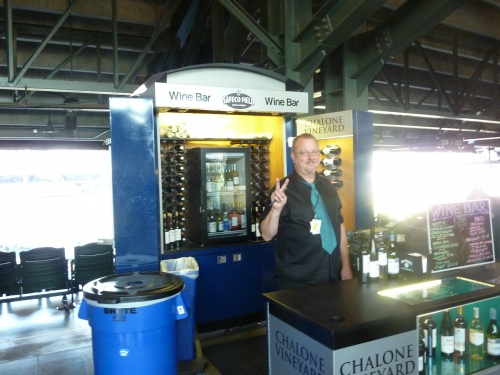
Score: 2/2
Bonus:
For being the most fan friendly ballpark in baseball, in so many respects +2
For the engineering marvel umbrella style retractable roof, that keeps the game open to the environment while still closed +2
For best concourses in baseball, with more standing room areas than ever seen in baseball +1
For the amazingly high quality food selection: +2
For The Pen, the most fan friendly feature in baseball. I can’t emphasize enough the openness and accessibility of this space. +1
For the art in the park: +1
Score: 9
Total: 14.5
Conclusion
Coming soon.
FINAL SCORE: 86
RANKING: #13(t)/30
Summary
TL;DR? Here’s the long-form piece in a nutshell:
Heralded for saving baseball in Seattle, T-Mobile Park has historically been considered one of the best parks in baseball, receiving rave reviews upon opening for its “umbrella”-style retractable roof that doesn’t enclose the park and unparalleled array of modern amenities. With a $500+ million price tag, an exorbitant amount for the late 1990s, almost no expense was spared.
Today, it seems like T-Mobile Park has faded from the limelight as a “must see” baseball cathedral—perhaps largely because of the Mariners now decades-long irrelevance coupled with geographic isolation.
Controversially, I’ve always been critical of the stadium’s architectural design. The exterior is utterly disjointed, with the third base side wrapped in red brick and the first base side exposed in unadorned steel. While some parts of the upper deck sport good views, T-Mobile’s interior visuals lack a defining focal point other than that bulbous roof, with poor attention to the urban context and haphazardly placed outfield grandstands. No sense of place from the lower bowl.
However, there’s no denying the fan-friendliness of the Mariners home. The gameday experience has aged well despite few ballpark enhancements other the years, because T-Mobile was way ahead of its time in offering those extra frills.
The food and craft beer are among the very best in baseball. The Pen is baseball’s prototypical social space. The main concourse is open to the field without interruption, and the concourses have so many cool SRO areas. The videoboard is one of baseball’s largest. The Mariners Hall of Fame and Museum, while a bit dated, is still a must-see attraction. And the “Art in the Park,” headlined by the chandelier of 1,000 translucent bats in the rotunda, remains the showstopper.
In sum, I think T-Mobile Park’s structure and aesthetics are overrated, but the rest of the fan experience remains top notch. Look for future renovations to further enhance the latter and improve T-Mobile’s standing.